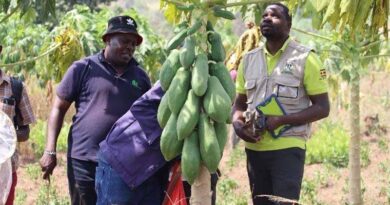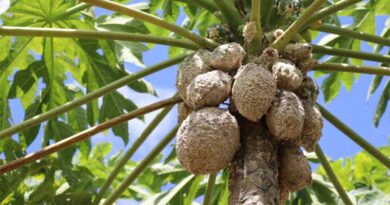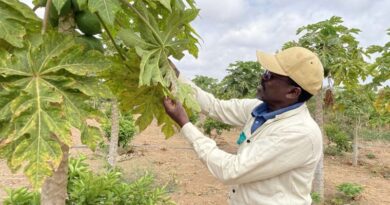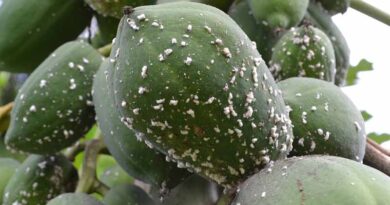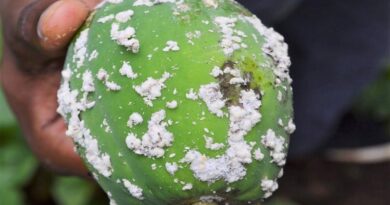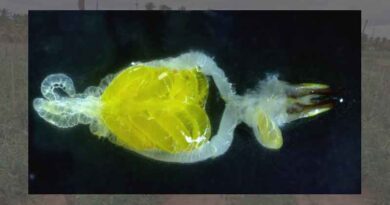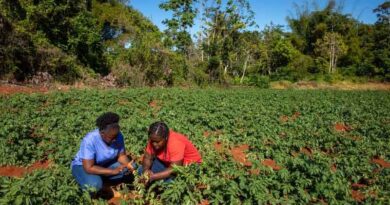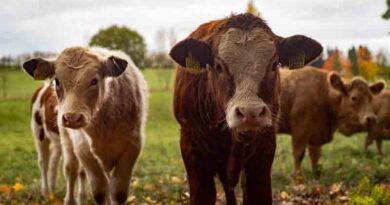Could biocontrol solve the papaya mealybug problem for Ugandan farmers?
14 September 2022, Uganda: Papaya mealybug, Paraccous margniatus, is native to Central America but has spread rapidly in invaded countries. It was detected in Uganda in 2021 where it has the potential to affect the production and quality of papaya and other host crops.
Typically, mealybugs are not pest problems in the countries they are native to because naturally occurring parasitoids and predators keep their numbers in check. The most serious outbreaks occur when mealybugs are introduced accidentally to new countries without natural enemies.
Papaya mealybug spread
The trade in live plant material, such as papaya fruits and seedlings, has accidentally accelerated the spread of papaya mealybug outside its native range. This pest threatens food and nutrition security and adversely affects the safe trade and competitiveness of the agricultural sector for many countries.
Without natural enemies to manage outbreaks, farmers often turn to pesticides. The lack of registered pesticides results in farmers using highly hazardous chemicals that are not only ineffective but can negatively impact native insect biodiversity such as pollinators and natural enemies of pests. A more ecologically sound approach to management is the use of biological control.
Rapid Rural Appraisal of papaya mealybug
As part of the PlantwisePlus programme, CABI in collaboration with the National Agricultural Research Organisation (NARO, Uganda), conducted a Rapid Rural Appraisal (RRA) of papaya mealybug in Uganda. The appraisal sought to gain an understanding of the presence, distribution, and impact of papaya mealybug in Uganda as well as farmers’ management practices. The evaluation also assessed farmers’ willingness to adopt and use biocontrol and their information requirements around biocontrol products.
Information from the appraisal will be used to design an integrated management strategy for papaya mealybug as well as help target community-level communications.
A major cash crop
The seventeen focus group discussions brought together papaya growers from four districts: North District (Lira), Central District (Kayunga, Luwero and Mukono). The districts captured a diversity of farming systems, agro-ecological zones, and agricultural potential. Papaya is a major cash crop for farmers in these districts, in addition to pineapple and traditional cash crops such as coffee. The average farmer cultivates the crop on 0.75-2.5 acres.
The participants confirmed papaya mealybug is already widespread in all four districts where it causes damage to several crops, not just papaya. Farmers started observing the pest between 2017 and 2019 with most saying it is a serious pest that can cause up to 100% crop loss. The official pest reporting to IPPC took place in 2021.
Papaya mealybug management
Farmers mainly attributed the papaya mealybug outbreaks to low productivity and poor-quality fruits. They observed that trees take longer to bear fruit and when they do, they only last one season compared to an average of 4 before. It was estimated that before the pest invaded, farmers obtained UGX 6-8 million/acre each season (£1,800), but currently only obtain UGX 1 million/acre each season (£230).
Regarding management options, commercial farmers reported using pesticides to deal with outbreaks. However, managing papaya mealybugs with pesticides is not always successful due to the pest’s waxy covering. In addition, misuse and/or improper use of these pesticides exacerbate pest problems by reducing beneficial organisms and natural enemies and negatively impacting biodiversity, human health and environmental safety. Further, some farmers don’t observe pre-harvest intervals, thus toxic substances are likely to enter the human food chain posing long-term health risks to consumers and the environment.
Sustainable options
Biological control represents a sustainable and effective management option, however, the farmers interviewed had mixed views on the method and the efficacy of the parasitoid in Uganda’s agroecologies. This highlights the importance of proper testing and community-level communications before the introduction of exotic natural enemies. Farmer and community engagement, and mass awareness are key in pest identification and management, especially with the promotion of unfamiliar pest management options. Extension in particular plays a vital role in the research and advancement of low-risk options.
However, one of the main takeaways from the appraisal was farmers’ papaya problems extend beyond papaya mealybug. Farmers reported other associated viral and bacterial diseases causing challenges, including bunchy top disease and leaf necrosis. As such, it is important that researchers assess the economic damage, effect and losses due to papaya mealybug and the associated pests and diseases before releasing biological control parasitoids.
Implementing a biocontrol programme
The PlantwisePlus programme is now looking at the activities required for the implementation of the biocontrol programme in Uganda. In particular, they are developing extension and farmer training manuals to cover papaya crop integrated pest management. These will include papaya mealybug as well as other pests affecting papaya production in the country. In addition, continuous community engagement and mass awareness campaigns will help farmers and their communities manage this highly destructive pest in a more sustainable way.
PlantwisePlus is working to reduce the reliance on high-risk farm inputs that have adverse effects on human health and biodiversity. By implementing biological control programmes, PlantwisePlus is responding to the challenge and working to improve livelihoods through sustainable approaches to crop production.
Also Read: Tractor sale in India lowest in two months; 32 percent down in August 2022
(For Latest Agriculture News & Updates, follow Krishak Jagat on Google News)


